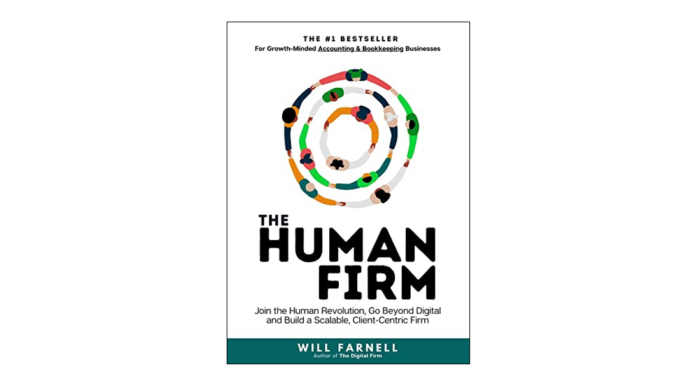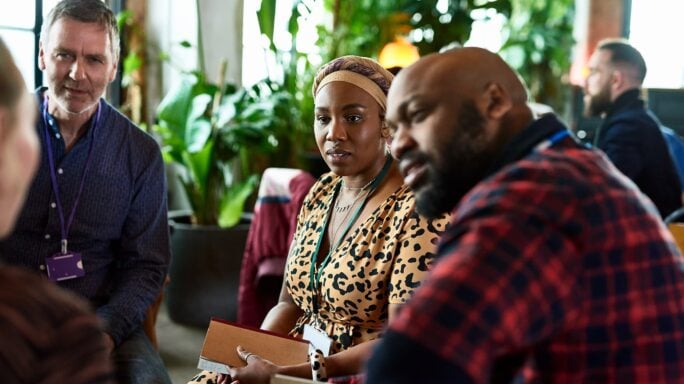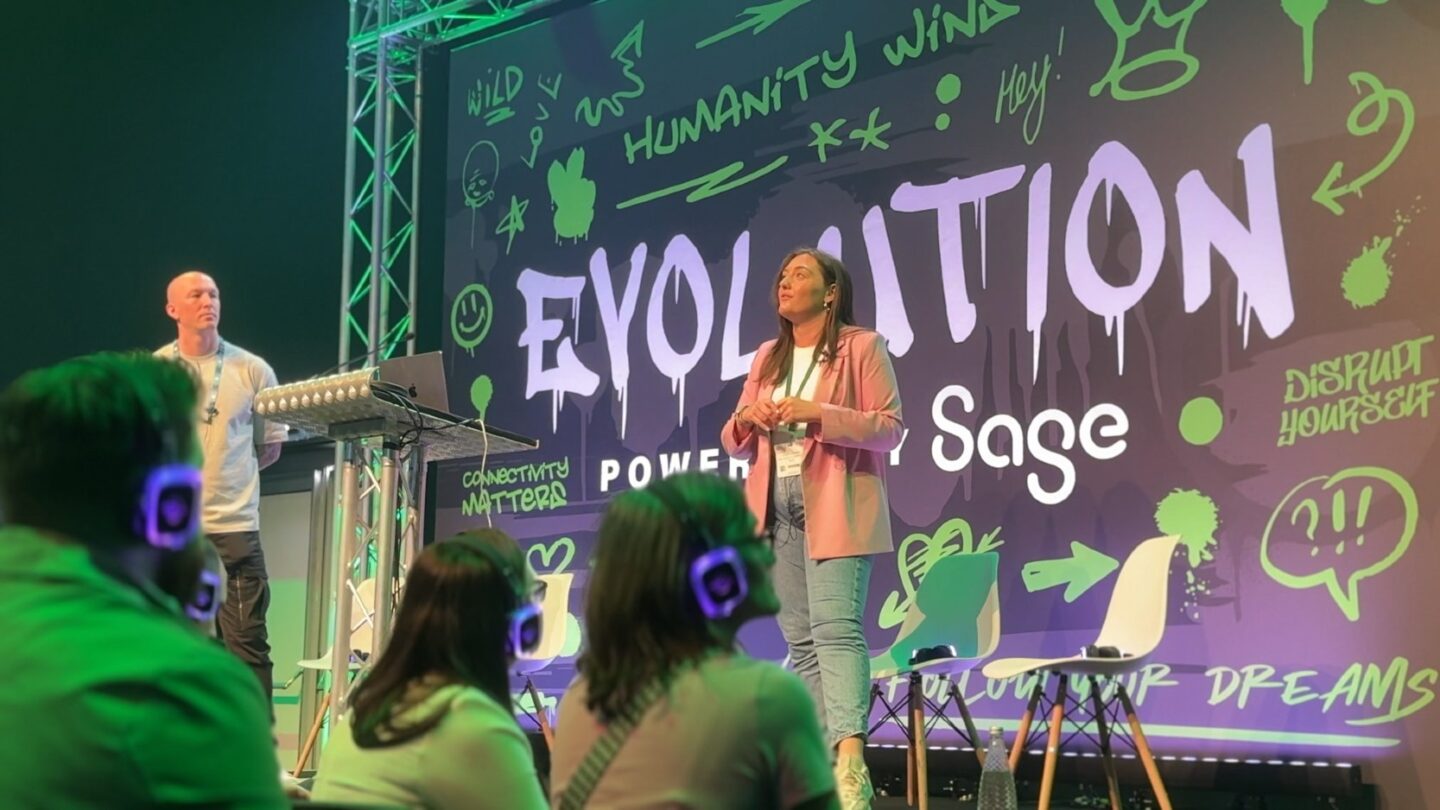People & Leadership
How to build a Human Firm in 5 easy steps
Discover how to move from a traditional accountancy practice model to a human-centric firm in five comprehensive steps.

When it comes to accountancy firms, adopting a human-centric approach is essential.
A human firm puts people at the core of its operations, prioritising personal connections, empathy, and client satisfaction. This approach ensures that technology complements the human element rather than replacing it.
Will Farnell, author of The Human Firm and the founder of the accountancy firm Farnell Clark, shares 5 easy steps to build a human business that combines the power of technology with a client-focused approach.
In this article, we cover:
- Become a digital firm
- Evolve from digital to human
- Build a culture of empathy and client-centricity
- Use technology in the right way and the right places
- Turn “good” into “great”
- Final thoughts
1. Become a Digital Firm
The first step is identifying the right tools. Choose solutions that enhance client relationships and team efficiency.
Will says: “To truly evolve into a ‘Human Firm’, you must ensure your accounting business harnesses technology effectively.
“A cornerstone of modern accounting is for your firm to become a digital entity—blending cutting-edge technology with digitally savvy personnel to provide top-tier services via optimal automation.”
Technology enhances client experiences.
Evaluate your current processes and identify areas where it can increase efficiency and accuracy.
- You can automate bookkeeping tasks like data entry or invoice processing, allowing your team to spend more time building client relationships.
- Ensure fast data input for better decisions. Effective tech boosts team efficiency and improves client interactions.
- Centralised bookkeeping and efficient systems allow daily transactions and weekly client communications. Simplified payment processes benefit everyone.
He adds: “Embracing technology is the starting point to crafting superior client experiences. By integrating the right tools, we ensure timely data input, laying the foundation for impactful decision-making.”
The right technology can help your team work more efficiently and deliver a better client experience, from cloud accounting software to client portals and communication tools.
Will highlights that “this isn’t just about removing paperwork; it’s about fostering connection and understanding their business pulse.
“The more purposeful touchpoints we have with our clients, the richer the relationship.
“Ultimately, it’s about harnessing technology in ways that both directly and indirectly amplify the client experience—that’s the essence of modern service delivery.”
He warns that having exceptional technology is fruitless if your team is reluctant or unable to use it. So, get everyone on board and discuss how technology can elevate the client experience.
Will also recognises that “At the heart of every accountancy firm I’ve encountered is a genuine concern for the client’s wellbeing.
“Strategically integrating technology not only boosts efficiency and precision but also preserves the irreplaceable human touch that differentiates your firm.
“Always remember—while technology is a potent enabler, you determine true worth by the people wielding it.”
Use data to make informed decisions
Digital tools can provide valuable insights into your client’s financial data, helping you make informed decisions that benefit their business.
Analyse the data to detect trends and spot areas for improvement, allowing you to provide tailored solutions and better customer support.
Insight can help you move from monthly or quarterly bookkeeping to more active financial data management. Ultimately, unlocking the power of this data could be the key to understanding your clients.
Will says: “When you harmonise people, process, and technology, you not only create capacity but also cultivate enhanced experiences for those you serve.
“Using technology to unlock this capacity is our starting point, enabling us to either elevate the services we offer or reimagine our brand and outreach to win new clients.”
The Human Firm
In this best-selling book, discover how you can revolutionise the way your practice operates and build deeper client relationships.

2. Evolve from Digital to Human
In decades past, accountants thrived on profound client relationships. But in time, an evolving regulatory landscape shifted focus towards compliance, moving away from those foundational connections.
We’ve come full circle with the advent of cloud and digital advancements. Unparalleled insights from daily bookkeeping and reporting restore and enhance your relationships.
Will says: “You are positioned better than ever to fortify your bonds with clients through data-driven knowledge.
“The digital evolution anchors you and can propel you to innovate, such as introducing services like HR to further embed in your client’s operations.
“In this digital era, don’t just reconnect. Deepen, enrich, and redefine your relationships with clients, to set unparalleled standards for the accounting profession.”
Differentiate your business
In Will’s book, a “Human Firm” is defined as a business with a top-notch team dedicated to its purpose.
Like Will’s business, your people need to understand your client’s goals and aspirations, aiming to consistently deliver unmatched client experience without sacrificing your people’s ambitions and objectives.
To become a “Human Firm”, you must transition from focusing on digital transformation to emphasising the human element.
Will said that with a “Digital Firm”, there was an emphasis on providing exceptional client experiences. But a crucial aspect was sometimes overlooked: Understanding a client’s true goals and aspirations.
He says: “As the digital landscape levels, nearly every firm can adopt identical technologies.
“This means that many can access webinars, hear from experts, and incorporate efficient processes into their setups, culminating in a level playing field.
“But here’s the catch: While you can replicate technologies and processes, you cannot replicate people.
People are your best asset and will help you find your competitive advantage.
Maximise human potential
With the rise of the “Human Firm”, the emphasis is on maximising human potential. There are 2 primary facets to this:
- Deep client understanding: It’s not just about understanding what a client wants. It’s about diving deep into their goals and aspirations.
- A-Team formation: Building a team committed to catering to clients while aligned with your organisation’s purpose.
Will says: “Previously, my model for the Digital Firm placed client experience at its core. However, the Human Firm model pivots this, positioning purpose and vision at its heart, which fuels client experience.
“This shift emphasises starting with a clear organisational purpose. What drives us? Once this foundation is solid, everything else, from client experiences to internal processes, will naturally align.”
Balance your client’s wishes with your people’s aspirations
Building a human accountancy firm is about nurturing trusting relationships with clients and caring for your team and wellbeing.
It starts with fostering a culture prioritising relationships, empathy, and personalised solutions.
A critical part of the “Human Firm’s definition revolves around balance.
Will says: “Asking where our clients see themselves in 5 years is crucial. But parallelly, we should pose the same question to our team.
“It’s this delicate equilibrium of aligning our team’s aspirations with our clients that propels a Human Firm forward.”
As we move from “Digital Firms” to “Human Firms”, the innate human touch, understanding, and aspiration will set leading organisations apart.
3. Build a culture of empathy and client-centricity
Will says that to drive the growth and success of any business needs 2 major elements—purpose and vision
Clarity of purpose
Fostering the right culture revolves around purpose. It will guide all your decision-making, so it must be people-driven, authentic, and vibrant.
Will says: “When I founded my firm, I had a clear vision—to revolutionise how professional services were delivered and perceived. This wasn’t just a lofty ideal; it was my driving force.
“This purpose-driven approach guided our decisions from adopting technology early on to redefining client engagements and reshaping our pricing models.”
- Engage your people in meaningful conversations and understand what resonates with them deeply.
- Ask questions, invite input, and foster open discussions.
- Empower your people to express their ideas, hopes and aspirations.
- Find the collective purpose that truly motivates your team, that’s larger than any individual or specific task.
- Your client and employee value proposition must communicate what your business does and how it operates so everyone is aligned and working towards the same goals.
Your vision
In the early days of his accountancy business, Will ensured every member who joined aligned with his firm’s mission. But as his firm grew, this changed.
He says: “As we scaled, a pivotal point occurred when we reached around 50 team members. I no longer had those foundational conversations with every new joiner at this juncture.
“That’s when we began to see a drift; not everyone was on the same page. We faced the real-world repercussions of a diluted sense of purpose. “This lack of alignment posed significant challenges; we even noticed a dangerous shift from a client-focus to a task-centric approach. This was a glaring issue for a firm committed to delivering world-class client experiences.”
This lesson underscores the importance of aligning all your people with the company’s vision.
Will says: “The moment you lose sight of that, problems arise. You must embed this mission in your company’s DNA.”
- Every business facet should mirror the company’s purpose, vision, and values, from reminders to performance evaluations.
- It demands ongoing effort to keep your team connected to the core mission.
- It’s not just about setting a purpose; it’s about continually weaving it into your organisation’s essence.
Your people
Here are some practical steps to embrace a human-centric culture in your accountancy firm:
Value relationships
Encourage your team to go beyond transactional interactions with clients.
- Teach them to build strong relationships based on trust, open communication, and mutual respect.
- Emphasise the value of long-term partnerships and how they contribute to the firm’s success.
Develop empathy
Empathy is a powerful skill. It lets your team understand and relate to clients’ challenges and aspirations.
- Train your staff to develop their empathy skills.
- Encourage active listening with the client’s needs in focus.
Care about your team’s wellbeing
In any accountancy practice, the wellbeing of your team is essential to delivering high-quality work and exceptional client service.
- Create a positive work environment and implement team empowerment strategies.
- Keep your team motivated and ready to deliver their best work.
- Foster open communication and promote a culture of mutual respect.
- Creates an environment where team members feel heard, valued, and supported.
- Encourage your people to be productive, creative, and collaborative.
Think about career development
Develop career opportunities for your employees, especially the younger generation, who strongly emphasise values and career progression.
- Invest in your team’s professional development to help them build the skills and knowledge they need to succeed.
Will shared a story where in 2015, his firm Farnell Clarke lost 6 team members in 8 weeks. That was 20% of the firm’s people.
He discovered that his former employees described a lack of career progression—despite the firm growing at 40% and bringing in many new clients.
Ensure all your team knows where they’re going and sees a clearly defined path regarding promotion and career development opportunities.
Balance your team’s workloads
Another important factor in your team’s wellbeing is balancing the workload.
Using technology to automate routine tasks:
- Free up your team’s time for high-value, client-focused, and potentially more enjoyable work.
- You’ll improve productivity and reduce stress and burnout.
Think seriously about workplace flexibility.
- Farnell Clarke, for example, has already moved from a 9-to-5 mentality to a “do the job you want as long as it gets done properly” approach.
- As well as keeping people happy, flexible working will give you an advantage in recruitment, as most accountancy firms are still office-based, which may not even be by choice.
4. Use technology in the right way and the right places
If you want to provide exceptional client experiences, making deliberate technological choices is crucial.
Technology should, directly and indirectly, positively impact your clients’ lives. Any process or tool you implement should enhance your relationship with your clients.
Will says: ” Client interests are central to accounting firms.
“Effective change must be rooted in the client’s view. Whether new tech boosts our efficiency and engagement or benefits the client’s business, they’re our focus.”
Your mission and values, while emphasising technology, should point you to use the best tech for superior client experiences. Your teams must embrace and live these values.
Use technology to automate tasks that don’t add direct value to the client—like data entry.
“Your people should repurpose time saved to foster genuine human interactions.
“After all, the quality of a client experience is defined by the cumulative value of each touchpoint from the beginning to the end of our relationship.”
Will says that to add value, you must transform these touchpoints: “Opting for a phone call over an email not only strengthens the relationship but can uncover deeper client needs, allowing us to assist them more profoundly.”
Think of your clients as more than just numbers on a balance sheet. They are individuals with unique goals, challenges, and dreams.
Your role is to provide exceptional service that exceeds their expectations. Here are some practical steps to prioritise client experience.
Add value to clients rather than piling on services
With normal bookkeeping work, you have data to help you understand what your clients are trying to achieve.
Focus on adding value to your clients rather than simply selling more services. Communication is key
Communication is the lifeblood of any successful relationship and is even more crucial in a human accountancy firm.
Stay engaged with clients regularly, not just during tax season. Actively listen to their concerns and provide proactive guidance. Promptly responding to their queries makes it easy for them to reach out for support.
By adopting efficient means of communication, you can ensure that you and your clients are always on the same page.
Embrace messaging platforms
Messaging platforms provide instant and secure communication with your clients.
- These platforms allow for real-time interactions, making it convenient for both parties to ask questions, share updates, and address any concerns quickly.
Personalise your approach
Tailor your services to meet the unique needs of each client. Treat every interaction as an opportunity to understand their goals and challenges better.
- Use technology to gather insights about their business and industry, allowing you to provide bespoke advice and solutions that add significant value.
Embrace video conferencing
Face-to-face meetings are not always possible. Video conferencing tools bridge this gap by providing a more personal and interactive experience.
- Use video calls for productive discussions by sharing screens and concepts. It offers a more meaningful connection with your clients and gives them more flexibility.
Collaboration
Encourage teamwork and collaboration within your firm. Create opportunities for your team members to share ideas, insights, and best practices.
- Foster collaboration so your staff can learn from one another, drive innovation, and ultimately provide better solutions to your clients.
- Work together virtually with tools that promote easy sharing and team editing of documents.
To businesses yet to embrace collaborative tools, Will suggests: “The sheer reduction in internal emails alone will revolutionise your focus.
“Monthly town halls or all-hands meetings are not just about updates; they’re platforms to underscore our purpose, culture, vision, and values.
Explore cloud-based platforms that allow for secure document sharing, real-time updates, and remote access to financial information.
Use project management software
Implement project management software to streamline your internal processes and enhance collaboration within your team.
These tools allow you to set clear goals, assign tasks, track progress, and share files in a centralised platform.
- By promoting transparency and ensuring everyone is on track, you can achieve better outcomes and deliver exceptional service to your clients.
Stay current
Stay current through resources like online training and webinars.
With cloud software, frequent updates ensure that you use the newest functionalities for your firm’s and your client’s benefit.
When Will’s firm recently introduced “product champions” within his teams, they helped steer technological progress and offered guidance.
He explained that these product champions “championed technology in alignment with our values and optimised client outcomes.”
Be cautious with technology
As you tread your technological path, Will advises caution.
He warns: “Merely superimposing technology onto flawed processes can intensify those flaws.
“Technology can amplify both the good and bad in our workflows. Before embedding any tech solution, one must ensure the underlying processes are sound.”
Will recalls an event where digital disruption was likened to removing process friction. And yes—while technology can eliminate certain frictions, it can also introduce new ones if misused.
“Our responsibility is to discern where technology enhances our objectives and where it might introduce unnecessary complications.
“While technology is a potent tool, we must ensure it enhances and doesn’t hinder the experiences we aim to deliver.”
5. Turn “good” into “great”
Every accountancy business goes through cycles of highs and lows. Service levels ebb and flow, but understanding your profession’s unique challenges and rewards lies at the heart of it.
Will says: “There’s a duality to being an accountant. The reassurance of gross recurring fees—a testament to the trust clients place in us year after year—can sometimes set a complacency trap.
“This inherently low bar for service standards can lead some just to do ‘enough.’ However, merely being ‘good’ is no longer satisfactory.
“Our vision should extend beyond delivering exemplary service to creating unforgettable client experiences.
“It’s less about the numbers and more about the emotional resonance. How do we make our clients feel safe, confident, and motivated?”
- The essence of your service should guarantee your clients peace of mind.
- It should assure them they’re in safe hands, free from regulatory nightmares.
Your interactions must leave a positive imprint on their lives, making a tangible difference. Such experiences foster client loyalty and promote organic growth through referrals.
Will says: “I often emphasise that if 70% of new business doesn’t originate from existing client referrals, it’s a clear signal for introspection. Such endorsements indicate that clients are genuinely impressed by your offerings.”
Continuously seek feedback
Regularly solicit feedback from your clients to gauge their satisfaction and uncover areas for improvement.
- Actively listen to their suggestions and implement changes that enhance their experience.
- Demonstrate your commitment to their success and tell them their opinion truly matters.
- Remember that each interaction with your client is an opportunity to build a long-lasting and fruitful relationship.
Your dedication to their success and satisfaction will set your firm apart. Embrace the customer-centric mindset and use technology to impact their lives positively.
Building understanding into your processes through data can help
Will says: “If we understand what our clients are striving to achieve and get good quality, current data through daily bookkeeping, we can help them deliver on their goals.
“Our focus should be on adding value to their lives. Doing so increases our revenue and creates a positive client experience.
You can build trust and loyalty for years by listening to your clients, offering valuable insights, and demonstrating a commitment to their success.
Use Net Promoter Score
Consider using Net Promoter Score (NPS), an excellent metric to gauge client satisfaction.
Will says: “Those who rate us a 9 or 10 are the true advocates, singing our praises to potential clients. So, our ambition should be to cultivate such promoters within our clientele.
“By doing so, not only do we ensure long-term client relationships, but we also pave the way for continued referrals.
Final thoughts on building a Human Firm
In today’s rapidly evolving landscape, success goes beyond mere professional expertise.
Taking cues from phenomena like the “Amazon effect”, your firm must continually challenge the status quo and seek innovative ways of operating.
While technology serves as a powerful tool, it’s the human-centric approach that truly differentiates a firm.
A successful firm not only harnesses the strengths of technology but also champions a culture centred on client needs, effective communication, and collaboration.
This balance fosters improved decision-making, heightened customer satisfaction, and robust team morale.
By placing people at the heart of your strategies and viewing technology as an ally, you can achieve growth and foster lasting partnerships with clients.
Essentially, the most resilient firms prioritise human value, use technology as a catalyst, and keep the client as their guiding star.








Ask the author a question or share your advice